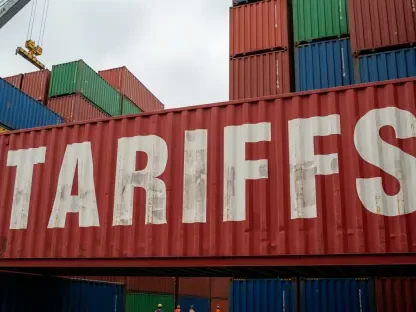Imagine a global landscape riddled with economic turbulence, geopolitical tensions, and unpredictable trade policies, yet one company stands tall amidst the chaos—China International Marine Containers (CIMC). In the first half of 2025, CIMC not only weathered these storms but also achieved remarkable growth across its diverse sectors, from container manufacturing to energy solutions. This roundup dives into a collection of opinions, tips, and analyses from industry experts, market observers, and business strategists to uncover how CIMC thrived against all odds. The purpose is to distill actionable insights and differing perspectives on what fueled CIMC’s success, offering a lens into resilience strategies for businesses navigating similar challenges.
Unveiling the Backdrop: CIMC’s Standout Performance Amid Global Struggles
In early 2025, the world grappled with fluctuating trade volumes, shipping disruptions, and energy market volatility driven by geopolitical unrest. CIMC, a titan in container manufacturing, logistics, energy, and offshore operations, emerged as a symbol of adaptability. Industry watchers have noted that the company’s ability to post significant revenue gains—particularly in its core segments—sets it apart from competitors struggling to maintain stability. This section explores varied viewpoints on why CIMC’s performance is a case study in navigating uncertainty.
Some market analysts emphasize that CIMC’s diversified portfolio acted as a buffer against sector-specific downturns. Unlike firms heavily reliant on a single industry, CIMC’s spread across multiple domains allowed it to offset losses in one area with gains in another. This perspective highlights the strategic foresight embedded in the company’s operational model, positioning it as a leader in turbulent times.
Others point to CIMC’s deep understanding of global trade dynamics as a key factor. Observers in the logistics field argue that the company’s knack for anticipating demand shifts, especially in container markets, enabled it to capitalize on emerging opportunities. This roundup will further unpack these insights, comparing opinions on specific segments and strategies that propelled CIMC’s growth.
Breaking Down CIMC’s Success: Diverse Opinions on Key Segments
Container Manufacturing: A Pillar of Strength in a Volatile Market
CIMC’s container manufacturing segment reported a staggering revenue of RMB21.735 billion in # 2025, with a net profit growth of 13.2%. Industry commentators agree that this success stems from sustained global trade demand, with CIMC selling 1.13 million TEU of dry containers and witnessing a 105.82% surge in refrigerated container sales to 92,000 TEU. Many attribute this to robust domestic demand in China and a resilient international market, viewing CIMC as a dominant force.
However, not all opinions align on the sustainability of this growth. Some trade experts caution that shipping market volatility and potential policy shifts could dampen future demand. They suggest that while CIMC’s current numbers are impressive, the company must prepare for possible disruptions in global trade agreements. This concern introduces a layer of caution to the otherwise optimistic outlook.
A contrasting view from supply chain analysts focuses on CIMC’s ability to innovate within the segment. They argue that the dramatic increase in refrigerated container sales reflects a strategic pivot toward niche markets with high growth potential. This perspective underscores the importance of adaptability, suggesting that CIMC’s focus on specialized products could be a blueprint for long-term dominance.
Logistics Operations: Navigating a Shaky Shipping Landscape
Turning to CIMC Logistics, the segment secured RMB13.579 billion in revenue, making it the second-largest contributor to the company’s earnings with a net profit of RMB202 million. Logistics professionals commend CIMC for maintaining steady operations despite a turbulent global shipping environment. Many highlight the company’s operational efficiency as a critical factor in sustaining profitability under pressure.
Differing opinions emerge on the risks ahead. Some industry voices warn that fluctuating container shipping dynamics pose a significant threat, urging CIMC to bolster contingency plans. They argue that external factors, such as port congestion or trade route disruptions, could erode gains if not addressed proactively. This viewpoint emphasizes the need for vigilance in an unpredictable sector.
On the flip side, business strategists see untapped potential in CIMC’s logistics arm. They suggest that investing in digital tools and optimizing supply chain networks could further solidify its market position. This optimistic take encourages a forward-thinking approach, positioning CIMC to turn challenges into competitive advantages through innovation and efficiency.
Energy and Offshore Sectors: Leveraging Niche Opportunities
CIMC Enric and CIMC Offshore also drew significant attention, with energy order backlogs reaching RMB29.18 billion and offshore revenue hitting RMB8.014 billion. Energy sector analysts praise the company’s ability to capitalize on regional oil and gas demand spikes, particularly amid geopolitical tensions. CIMC Raffles’ order pipeline of $5.55 billion is often cited as evidence of strong future prospects.
However, opinions diverge on the role of oil price dependency. Some market observers argue that fluctuations in crude oil prices, influenced by global policies, could jeopardize growth in these segments. They advise a cautious approach, warning that over-reliance on volatile markets might expose CIMC to unforeseen risks in the coming years.
A counterargument from energy consultants suggests that CIMC’s diversified energy portfolio mitigates such concerns. They point out that the company’s broad range of solutions, spanning various energy needs, reduces exposure to single-market swings. This perspective champions diversification as a shield, offering a more balanced view of CIMC’s potential in this arena.
Strategic Adaptability: Turning Challenges into Wins
Across all segments, CIMC’s overarching strategy of adaptability garners widespread acclaim. Business thought leaders note that the company’s knack for balancing growth across sectors sets it apart from single-focus competitors. They argue that this multi-pronged approach not only mitigates risks but also positions CIMC to seize opportunities in dynamic markets.
Some analysts draw comparisons with industry peers, highlighting that CIMC’s proactive response to external pressures—such as trade policy shifts—offers a stark contrast to more reactive firms. This viewpoint suggests that strategic foresight, rather than mere reaction, is the cornerstone of CIMC’s resilience, providing a model for others to emulate.
A slightly different angle comes from risk management experts who speculate on future challenges. They propose that CIMC’s adaptability could be tested by emerging issues, such as supply chain bottlenecks or geopolitical escalations, in the latter half of 2025. This forward-looking concern adds depth to the discussion, urging continuous evolution in strategy to maintain momentum.
Lessons from CIMC’s Triumph: Industry Takeaways and Tips
CIMC’s standout achievements in # 2025—from soaring refrigerated container sales to robust energy order backlogs—offer a treasure trove of lessons. Business advisors widely agree that diversifying revenue streams is a critical takeaway, as it shields companies from sector-specific downturns. CIMC’s ability to thrive across multiple industries underscores the value of a balanced portfolio in uncertain times.
Another key insight, shared by market strategists, is the importance of targeting niche demands. CIMC’s success with specialized products like refrigerated containers illustrates how focusing on high-growth areas can drive profitability. This tip encourages firms to identify and invest in underserved markets as a pathway to growth.
Operational flexibility also emerges as a recurring theme among industry opinions. Experts suggest that businesses analyze market trends regularly and adapt processes to stay ahead of disruptions. Drawing from CIMC’s playbook, this practical advice emphasizes agility as a cornerstone of resilience, urging companies to build adaptable frameworks for sustained success.
Reflecting on CIMC’s Journey: Next Steps and Future Outlook
Looking back, CIMC’s performance in the first half of 2025 served as a powerful reminder of what strategic resilience could achieve amidst global upheaval. The insights gathered from various industry perspectives painted a picture of a company that not only survived but excelled by leveraging diversification and innovation. The discussions around container manufacturing, logistics, energy, and offshore segments revealed a shared admiration for CIMC’s ability to turn challenges into stepping stones.
Moving forward, businesses inspired by this success might consider adopting a similar multi-faceted approach, starting with an audit of their own portfolios to identify diversification opportunities. Exploring niche markets, as CIMC did with refrigerated containers, could unlock new revenue streams. Additionally, investing in technology to enhance operational efficiency stands out as a practical next step for those aiming to mirror CIMC’s adaptability in an ever-shifting global landscape.









